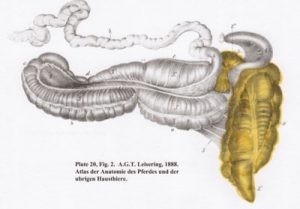Equine Colic Types
Cecal lesions

Predispositions to disease
The cecum is a blind ended sack with a single entry and exit portal. As it is a branch off of the rest of the intestines, motility disorders can lead to impactions.
Tapeworms live at the ileocecal junction and can cause motility issues and intussusceptions
Cecal impactions develop most commonly in horses that are hospitalized and on NSAID therapy. Due to chronic pain, horses with orthopedic issues or eye lesions are predisposed.
Clinical signs
Horses with cecal disorders often just show low grade pain. Distension takes time to develop.
Gas distension is palpable rectally with tight vertical bands but may resemble other forms of gas colic. Some horses will develop a cecal ping on the right side.
Impactions will cause the cecum to sink and to be less palpable. Impactions are generally not identifiable until advanced.
Many of these cases are are on NSAIDs because of the primary eye or orthopedic conditions. The presence of ongoing pain relief means early signs of colic may be missed.
Therapy
Horses with cecal tympany (gas vs impaction) often respond well to pain relief, antispasmodic agents, mineral oil and exercise.
Due to the increased risk of rupture with cecal impactions, these horses should be referred. Most substances bypass the cecal contents and move from the ileum, straight thru the cecum into the colon. Surgery is often necessary to empty the cecum.

